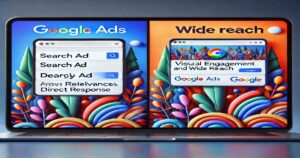Running Google Ads for your mid-sized business can be a game-changer in the world of digital marketing. When done correctly, it opens doors to a vast audience and helps you drive meaningful traffic, generate leads, and ultimately, increase sales. However, for mid-sized businesses, navigating the complexities of Google Ads requires a strategic approach to ensure maximum return on investment (ROI) without overspending. This guide will walk you through the essential steps and strategies to run successful Google Ads campaigns tailored specifically for your business needs.
Why Google Ads is Essential for Mid-Sized Businesses
Google Ads offers unparalleled reach and precise targeting, making it an essential tool for mid-sized businesses aiming to compete in today’s market. Unlike traditional advertising methods, Google Ads allows you to:
- Reach a broader audience by appearing in Google search results and on partner websites.
- Target specific demographics and interests, ensuring your ads reach potential customers.
- Measure your success with detailed analytics, allowing you to track performance and adjust campaigns in real-time.
By investing in Google Ads, mid-sized businesses can achieve measurable growth, driving both online visibility and revenue. For more on why PPC is crucial for businesses of all sizes, check out our detailed guide on PPC for Mid-Sized Portland Businesses.
Setting Up Your Google Ads Account
To get started with Google Ads, follow these steps:
- Create a Google Ads account by visiting the Google Ads homepage and signing up.
- Organize your campaigns by setting up different campaigns for each product or service you offer. This structure allows for more precise tracking and optimization.
- Link your Google Analytics account to your Google Ads account. This step is crucial for gaining insights into how users interact with your site after clicking on your ads.
Properly setting up your account is the foundation of a successful Google Ads strategy. It ensures that your campaigns are organized and your data is trackable from the start.
Understanding Google Ads Campaign Types
Google Ads offers several campaign types, each designed to meet different marketing goals:
- Search Campaigns: Show text ads in Google search results, ideal for capturing intent-based traffic.
- Display Campaigns: Use visually engaging ads on Google’s Display Network, perfect for brand awareness.
- Video Campaigns: Advertise on YouTube, which is effective for storytelling and engagement.
- Shopping Campaigns: Showcase your products directly in Google search results, driving retail traffic.
- Smart Campaigns: Automate your ad placement and targeting, a good option for those with limited time or expertise.
Choosing the right campaign type depends on your business goals. For instance, if your goal is to drive immediate sales, a Search or Shopping campaign might be the best fit. On the other hand, Display or Video campaigns are excellent for building brand awareness. You can also explore more strategies in our article on Maximizing Success in PPC Advertising.
Comparison of Google Ads Campaign Types
| Campaign Type | Best For | Key Benefit |
|---|---|---|
| Search Campaigns | Capturing intent-based traffic | High relevance, direct response |
| Display Campaigns | Building brand awareness | Wide reach, visual engagement |
| Video Campaigns | Storytelling and engagement | High engagement, rich media |
| Shopping Campaigns | Retail and eCommerce | Product visibility, higher CTR |
| Smart Campaigns | Automated ads, limited time | Simplicity, automation |
Keyword Research and Selection
Keyword research is the backbone of any successful Google Ads campaign. Here’s how to do it effectively:
- Use tools like Google Keyword Planner to discover relevant keywords that your potential customers are searching for.
- Analyze keyword metrics such as search volume, competition, and cost-per-click (CPC) to select the most valuable keywords for your campaigns.
- Focus on long-tail keywords that are specific to your products or services. These tend to have lower competition and higher conversion rates.
Selecting the right keywords ensures your ads appear in front of the right audience, increasing the likelihood of clicks and conversions.
Crafting Compelling Ads
Creating ads that capture attention and drive clicks is an art form. Here are some best practices:
- Write compelling headlines that include your primary keywords and address your audience’s pain points.
- Craft clear and concise ad copy that highlights the benefits of your products or services.
- Use A/B testing to experiment with different headlines, ad copy, and calls-to-action (CTAs). This approach allows you to identify which versions resonate best with your audience.
A well-crafted ad not only grabs attention but also encourages the user to take action, such as clicking on your ad or making a purchase.
Budgeting for Google Ads
Setting a realistic budget is critical for managing your Google Ads campaigns effectively:
- Determine your overall budget based on your business’s marketing goals and available funds.
- Allocate your budget across campaigns depending on their importance and potential ROI. For example, you might allocate more budget to a campaign promoting your best-selling product.
- Understand bidding strategies, such as manual CPC, automated bidding, and enhanced CPC. Choose the strategy that aligns with your budget and goals.
Budget management ensures you’re getting the most out of your investment without overspending. You can further explore how to optimize your spending by reading our article on Optimizing Google Ads for Mid-Sized Biz Success.
Sample Budget Allocation for Google Ads Campaigns
| Campaign Type | Percentage of Total Budget | Example Monthly Budget ($5000) |
|---|---|---|
| Search Campaigns | 50% | $2500 |
| Display Campaigns | 20% | $1000 |
| Video Campaigns | 10% | $500 |
| Shopping Campaigns | 15% | $750 |
| Smart Campaigns | 5% | $250 |
Targeting the Right Audience
Effective audience targeting is key to ensuring your ads reach the most relevant users:
- Utilize demographic targeting to reach users based on age, gender, income level, and more.
- Use interest-based targeting to show your ads to users who have shown interest in topics related to your business.
- Leverage remarketing to target users who have previously visited your site, keeping your brand top-of-mind.
By refining your audience targeting, you increase the chances of your ads being seen by those most likely to convert.
Monitoring and Optimizing Your Campaigns
Once your campaigns are live, continuous monitoring and optimization are essential:
- Track key metrics such as click-through rate (CTR), cost-per-click (CPC), and conversion rate to gauge performance.
- Identify underperforming ads and make necessary adjustments, such as tweaking ad copy or refining keywords.
- Use automated rules and scripts to optimize bids, pause low-performing ads, and more, saving you time and improving efficiency.
Regular optimization ensures your campaigns remain effective and continue to deliver results. Discover more advanced techniques by visiting our post on Mastering PPC in Oregon.
Leveraging Google Ads Extensions
Ad extensions enhance your ads by providing additional information and improving visibility:
- Sitelink extensions allow you to include additional links to your website within your ad.
- Callout extensions highlight unique selling points or special offers.
- Structured snippet extensions provide more details about your products or services.
Using the right extensions can increase your ad’s effectiveness, leading to higher CTR and improved ad rank.
Conversion Tracking and Analysis
Tracking conversions is vital to understanding the effectiveness of your Google Ads campaigns:
- Set up conversion tracking in your Google Ads account to monitor actions like purchases, form submissions, or phone calls.
- Analyze conversion data to identify which campaigns, ads, and keywords are driving the most valuable actions.
- Use this data to refine your targeting, adjust your bids, and allocate budget more effectively.
By tracking conversions, you can make data-driven decisions that improve your ROI.
Avoiding Common Google Ads Mistakes
Many mid-sized businesses make common mistakes that can hinder their Google Ads success:
- Neglecting negative keywords can lead to wasted spend on irrelevant clicks.
- Overlooking ad extensions means missing out on potential enhancements to your ads.
- Failing to optimize landing pages can result in high bounce rates and low conversion rates.
Avoiding these mistakes can significantly enhance the performance of your Google Ads campaigns. For more insights, check out our Guide to Generating Leads with Google Ads.
Common Google Ads Mistakes and Solutions
| Mistake | Impact | Solution |
|---|---|---|
| Ignoring Negative Keywords | Wasted ad spend | Regularly update negative keyword list |
| Overlooking Ad Extensions | Lower CTR | Use appropriate extensions |
| Not Optimizing Landing Pages | High bounce rates | Improve landing page relevance |
Using Google Ads in Conjunction with Other Marketing Channels
Google Ads works best when integrated with other marketing efforts:
- Complement your SEO strategy with Google Ads to cover both organic and paid search results.
- Use Google Ads in tandem with social media marketing to reinforce your brand message across multiple platforms.
- Adopt a multi-channel approach to maximize reach and engagement, ensuring a cohesive marketing strategy.
A well-rounded marketing approach leverages the strengths of multiple channels for greater impact. Learn how this integration works in our post on Effective Online Marketing Strategies.
Advanced Strategies for Maximizing ROI
To take your Google Ads campaigns to the next level, consider these advanced strategies:
- Explore automated bidding strategies like target CPA and ROAS to optimize for conversions.
- Implement remarketing lists for search ads (RLSA) to target users who have already shown interest in your business.
- Use dynamic search ads to automatically show ads based on the content of your website.
These strategies can help you get more from your Google Ads investment by driving higher-quality traffic and increasing conversions.
Case Studies: Success Stories of Mid-Sized Businesses Using Google Ads
Looking at real-life examples can provide valuable insights:
- Case Study 1: A mid-sized eCommerce business saw a 150% increase in sales by using Shopping campaigns and remarketing.
- Case Study 2: A local service provider doubled their leads by focusing on local targeting and optimizing their ad copy.
- Case Study 3: A SaaS company reduced their cost-per-acquisition by 30% through advanced bidding strategies and A/B testing.
These success stories illustrate how other businesses have effectively used Google Ads to grow and can inspire your strategy.
Preparing for Future
Trends in Google Ads
The digital marketing landscape is always evolving, and staying ahead of trends is crucial:
- Stay informed on upcoming trends like AI-driven ads and voice search, which will shape the future of Google Ads.
- Adapt to changes in consumer behavior, such as the increasing use of mobile devices and video content.
- Future-proof your strategy by being flexible and willing to test new approaches.
Being proactive about future trends ensures your Google Ads campaigns remain competitive.
Conclusion
Running Google Ads for your mid-sized business can drive significant growth if done correctly. From setting up your account and choosing the right keywords to optimizing your campaigns and preparing for future trends, this guide has provided the tools and strategies needed to succeed. Start your journey with Google Ads today, and watch your business reach new heights.
Call to Action: Contact Nesace Media today for expert guidance and management of your Google Ads campaigns, ensuring your mid-sized business achieves the success it deserves.
Key Takeaways:
- Keyword research is crucial for targeting the right audience and driving conversions.
- Regular monitoring and optimization of your campaigns ensure ongoing success.
- Integration with other marketing channels enhances overall marketing effectiveness.
FAQs
1. How long does it take to see results from Google Ads?
Results from Google Ads can vary depending on your industry and strategy. Typically, you can start seeing data and trends within a few weeks, but significant results may take a few months as you optimize your campaigns.
2. What budget should a mid-sized business allocate to Google Ads?
The budget varies based on your goals and industry competition. A good starting point is to allocate 5-10% of your revenue to advertising, adjusting as needed based on performance.
3. How can I improve the quality score of my Google Ads?
Improving your quality score involves optimizing your ad relevance, expected CTR, and landing page experience. Ensure your keywords align closely with your ad copy and that your landing page provides a good user experience.
To deepen your understanding of PPC, consider reading more about the importance of PPC on the Google Ads Help page.




